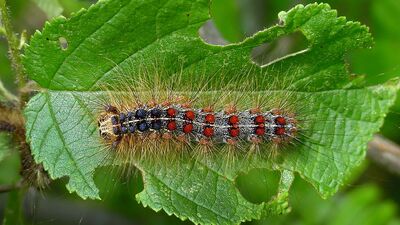Rainy Weather Helping Reduce Spongy Moth Caterpillars
Friday, June 21st, 2024 -- 9:01 AM

(Jonah Beleckis, Wisconsin Public Radio) Over the last few weeks, spongy moth caterpillars have been dying off in some parts of Wisconsin, thanks to rainy weather hurting the invasive species.
According to Jonah Beleckis with Wisconsin Public Radio, PJ Liesch, an entomologist with the Division of Extension at the University of Wisconsin-Madison, said the rain boosts a fungus that can kill the caterpillars.
“The rainy weather has really been helping us out,” he said Wednesday on WPR’s “The Larry Meiller Show.” Spongy moths are invasive insects that are native to Europe, Asia and North Africa. The caterpillars are destructive because they can strip leaves from entire forests.
Last year, Wisconsin saw record spongy moth defoliation of 373,000 acres, topping a record of 347,000 acres that had stood since 2010, according to the state Department of Natural Resources. Liesch said spongy moths can pose a serious risk to trees in forested areas and urban spaces.
“It’s something that has been on my radar because if you have, say, oak trees that are defoliated again and again, they start running ragged,” he said. “Then, you get secondary issues that pop up. Over the course of a few years, if that continues, it’s not a good trajectory for the plants.”
A dry year, like Wisconsin recently saw, can cause spongy moth populations to rise. But damp conditions can allow a fungus, known as Entomophaga maimaiga, which Liesch said is dangerous to spongy moths, to thrive.
The fungus can go through a generation in about a week or so, and more fungus spores mean more exposed caterpillars. When there are more caterpillars thanks to a rising population, that means they are more likely to be packed together in proximity.
Liesch said this leaves spongy moth caterpillars more susceptible to spreading a fatal virus. He also explained that seeing how the dead caterpillars lie can give clues as to what killed them. When the fungus is responsible, the caterpillars hang straight down.
When a virus is the killer, the caterpillars remain attached to the tree at the middle of their bodies and hang in an inverted-V shape. Liesch said the fungal disease is harmless to trees, people and pets. It specifically affects these caterpillars.
Feel free to contact us with questions and/or comments.




